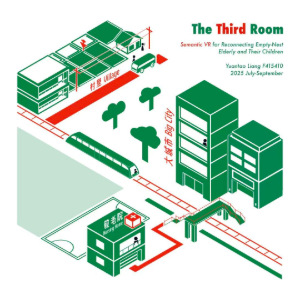Inspired by the rising challenge of empty-nest syndrome in modern multi-generational societies, this Master's project introduces The Third Room—a groundbreaking Semantic Virtual Reality (VR) co-telepresence platform. This virtual space using development tools allows empty-nest parents and their distant adult children to reconnect in a self-tailored, familiar setting, fostering a crucial sense of emotional presence and interaction to combat loneliness and improve overall wellbeing.
Using Semantic VR, this student built "The Third Room," a personalised virtual space where families separated by distance can share meaningful, embodied moments.
Forget video calls, this is co-telepresence.
The Third Room a virtual online space where empty-nest parents can spend time with their far-flung adult children in self-tailored settings that seem familiar and comfortable.
My research suggests that – although by no means a new phenomenon – empty-nest syndrome is rapidly becoming a widespread problem in countries like China where multi-generational households were previously the norm.
I’ve also learned that as well as struggling with loneliness and depression, empty nesters can be susceptible to other health conditions like high blood pressure, diabetes and a decline in cognitive ability.
What initially inspired you to tackle this specific social challenge?
The Third Room is my way of addressing this – providing a digital space where families can interact and reconnect, improving the emotional and physical wellbeing of empty-nest parents.
Unlike conventional remote communication tools that tend to focus on efficiency, I want The Third Room to foster a deeper sense of co-telepresence. By integrating technical realism, personalised objects, memories and embodied interactions I want the space to have cultural and emotional significance for its users.
Collaborating with a care home manager, I confirmed the positive potential of a virtual reality (VR) family meeting place and started to shape the content of my prototype.
As well as using my graphic design skills alongside the qualitative research methods acquired during my master’s, I had to get to grips with some new technologies to develop my prototype. I’m now a proficient user of Unreal Engine 5, Kinect and RealityCapture.
Which of those new technologies proved to be the biggest learning curve?
These tools allowed me to create my 3D space (Unreal Engine), furnish it with scanned objects (RealityCapture) and move within it (Kinect).
Allowing The Third Room’s visitors to interact within the space – using VR headsets and other tools that support embodied interaction – is a really important element of my project. I want families to feel as if they really are together, not just talking via a screen with a suitable backdrop.
There’s so much to learn in this sphere. Needless to say, I am continuing to develop my hands-on, practical skills and theoretical knowledge.
What did your early user testing reveal about the sense of "being together" in The Third Room?
One important thing I’ve learned about the research process is to challenge yourself. Step out of your comfort zone. Focus on identifying a real challenge and elaborate a meaningful, satisfying design solution.
My master’s project has inspired me. I’ve decided to continue working on The Third Room, making it the starting point of my doctoral research. I want to advance my theoretical and design frameworks. As part of this, I would like to collaborate further with care homes to explore how the prototype can be refined and applied in these settings.
Visit the School of Design and Creative Arts' Postgraduate Showcase 2025 to explore more designs like this.
